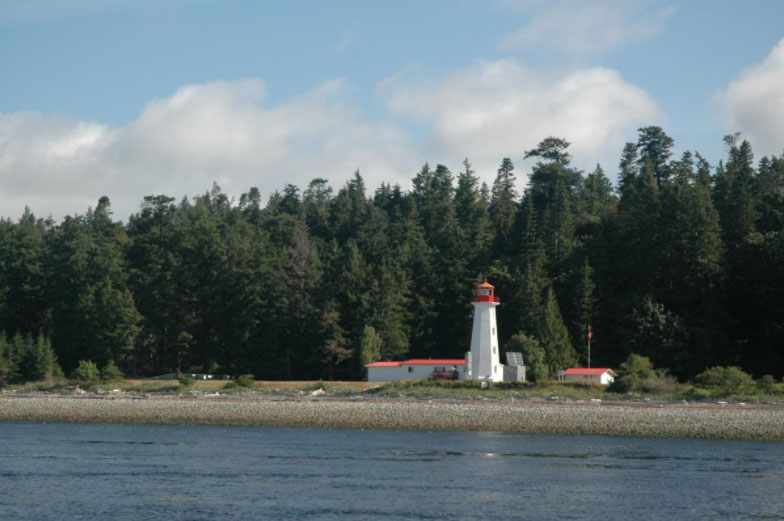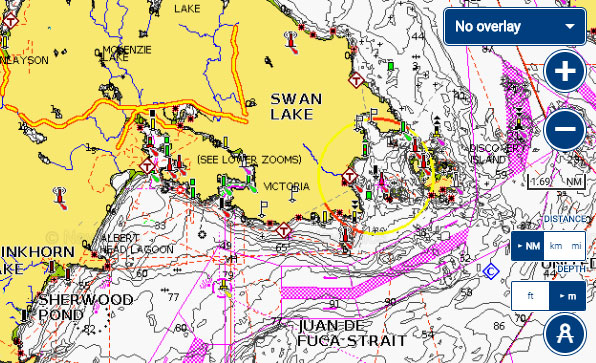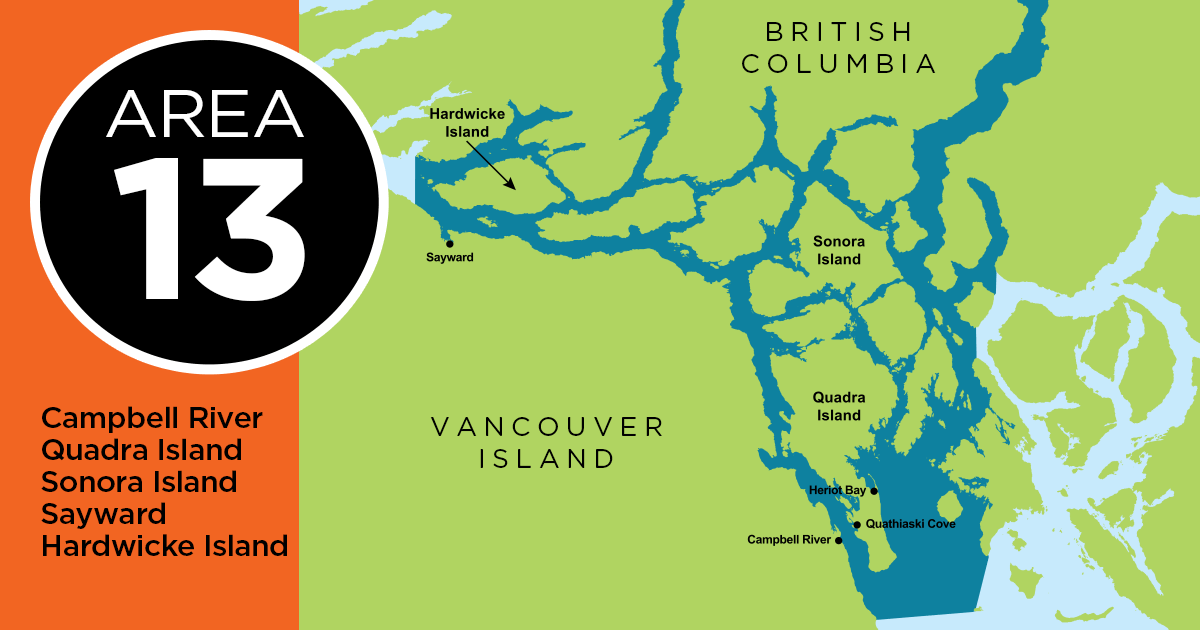

August 2016
My 16-foot Lund was heading back to Campbell River boat launch. My fishing partner Barry Mills was sitting next to me.
Only a few seconds earlier I had been standing at the back of the boat, when a sharp tug announced business at the opposite end of my rod. I lifted upward, expecting to see the first of our hoped-for catch of rockfish popping to the surface. We were meat fishing, pure and simple, for a feed of fish and chips planned at my house later that evening. Nothing happened—at first. There was just a very solid weight, then whatever was down there swam directly away from the boat. My upraised arm snapped down, then a loud yelp of pain and surprise rang out over the water as my knuckles rapped hard against the reel.
The “thing” was dragging me across the boat! I quickly jammed both feet against the boat and braced myself. The boat tilted precariously and began moving slowly toward the centre of the channel. Our unusual mode of transportation was short lived, however, perhaps 15 feet or so. At that point the heavy Siwash hook straightened and I nearly back-flipped over the opposite side of our craft.
What was it? Who knows. Whatever, it had more than enough strength to haul my 225-pound frame with that short tug of war. A giant skate? Perhaps. They frequent the harbour, and specimens have been caught weighing in the neighbourhood of 200 pounds. An oversized lingcod? Maybe. They have been recorded at weights of over 100 pounds, which would probably be of a size large enough to duplicate that day’s activities. Halibut? Doubtful, but not entirely impossible, but anglers will be the first to agree there are seldom any hard-and-fast rules concerning where fish should or should not be.
As is so often the case when fishing saltwater, my mystery monster will remain precisely that—something to muse over and contemplate until my final day.
Other anglers are occasionally a bit luckier—or perhaps more skillful—when “things” are encountered. My buddy Tom Anderson arranged a boat tour for a group of young ladies. As they cruised slowly down Baynes Sound, between Denman Island and the eastern shore of Vancouver Island, a passenger commented on a handline nestled on one of the shelves. To it was attached a heavy Norwegian jig sporting a huge treble hook. Anderson explained that the rig was used for catching bottom fish, but he detected more than a little doubt in the eyes of his audience. As they happened to be over an area known to be productive for rockfish, he stopped the boat and proceeded to give a short demonstration.
The big lure was tossed into the water, where it quickly plunged from sight. As soon as he felt bottom, Anderson pulled the lure up a few feet, then started working it up and down to attract a fish. As is so often the case in bottom fishing, something grabbed it immediately. Anderson heaved on the line, staggered, and almost pitched over the railing. Recovering his balance, he braced his feet and started to slug it out with something much larger than the anticipated rockfish.
The passengers crowded around their skipper to better see what was causing all the commotion. When a huge, mottled head with a gaping mouth filled with large teeth suddenly poked out of the water, there was an immediate thinning of ranks as safer parts of the vessel were sought. Anderson heaved the 60-pound lingcod aboard, then calmly stated, “See ladies? That’s all there is to using a cod jig.”
Don Gordon once took a visiting Albertan on a day’s outing for salmon. They headed south from Comox, trying various locations along the eastern shoreline of Denman Island, then swinging across the mouth of Lambert Channel to fish along the eastern side of Hornby Island. The salmon refused to co-operate, so Don decided an hour or so of bottom fishing off the southern end of Denman Island would break the monotony. Shortly after their jigs had started probing the waters near Deep Bay, Gerald Muston’s rod suddenly bent under a heavy strain. The first thought crossing their minds was that he had snagged a sizeable chunk of underwater real estate. Then “bottom” suddenly started pulling line from the reel in a most fish-like manner.
Don manned the controls, jockeying the boat’s position while Gerald strained his 25-pound-test line to the breaking point. The battle continued for some 45 minutes before the “thing” was finally derricked to the surface. The next problem facing the duo was what to do with the dining-room-table-sized skate that was floundering at boatside.
“I gaffed it through the snout,” Don related, “and we hauled it into the boat. Problem was it took up the whole cockpit.” He chuckled and shook his head as he recalled the event. “We retired rather quickly to the cabin to think about our next move. It did a pretty good job of rearranging the tackle boxes and rods before I finally found a hammer in the tool box. I reached out through the hatch and belted it between the eyes—which is what I should have done before we brought it over the side.”
The big skate was later weighed on government-approved scales—a very respectable 80 pounds. It also supplied a veritable mountain of tasty meat for the freezer.
It is vignettes such as these that lure many of us out in small boats to probe the sea’s bottom. More often than not, for every monster hooked, there are hundreds of smaller fish with which to contend. But even lesser fish offer excitement and the chance to put food on the table.
There is no disputing the fact that salmon are, and will, we hope, remain the glamour fish of British Columbia’s saltwater scene. No one who has ever tangled with an acrobatic coho or a supercharged Chinook will deny their fighting abilities. However, this unabashed love affair with salmon contributes to the lack of exploitation of several other species available for recreational angling.
One of my well-used reference books, Fishes of the Pacific Coast of Canada, lists 271 species of saltwater-dwelling fish. The majority are either too small or too inaccessible to consider for recreational fishing, but there are more than enough left over to pique the interest of anglers who might be eager to try something different. Shark fishing is an intriguing example.
Excluding Pacific dogfish, of nine shark species said to occur off the British Columbia coast, four are actively sought as game fish in other parts of the world. Showing their approximate maximum size in brackets, they are the sixgill (25 feet), thresher (25 feet), salmon (10 feet), and blue (25 feet).
Let’s face it, with fish of these sizes, anglers accustomed to using outstretched hands to indicate the size of their catch would have to adopt the “Texas method” of measuring between the eyes.
Many species of fish capable of attaining large sizes and hefty weights are known to frequent coastal waters. That most are not considered “game fish” in the eyes of salmon-oriented anglers borders on the ridiculous.![]()
Visit the Store
$34.99
$34.99
Featured Catch

Joel Unickow halibut (Photo: Rob Frawley Lucky Strike Sportfishing Tofino)







